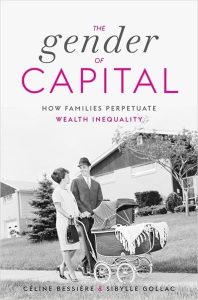In The Gender of Capital: How Families Perpetuate Wealth Inequality, Céline Bessière and Sibylle Gollac argue that despite supposed equality, women in all classes of society are economically disadvantaged with respect to their husbands, fathers, and brothers. Bessière and Gollac present an accessible, thoroughly researched analysis of how the institution of the family and its legal protections disempower and impoverish women, writes Khushbu Sharma.
The Gender of Capital: How Families Perpetuate Wealth Inequality. Céline Bessière and Sibylle Gollac, translated from the French by Juliette Rogers. Harvard University Press. 2023.
 “I left everything to my wife: the children, the debts, the headaches.” – quoted from an interview in The Gender of Capital, p. 131.
“I left everything to my wife: the children, the debts, the headaches.” – quoted from an interview in The Gender of Capital, p. 131.
The COVID-19 pandemic shook the world and raised many critical questions for academics and social scientists to consider. One such question – which has long preoccupied economists to political scientists but started receiving a renewed attention post-pandemic – is that of globally increasing wealth inequality. Feminist interventions into this question have repeatedly shown that this inequality is not just classist but also gendered in nature, rooted in women’s oppression. Vicky Pryce’s Women Vs Capitalism: Why Can’t We Have It All in a Free Market Economy, published in 2019, threw into relief how the capitalist economic system strategises to maintain and even accentuate the wealth inequality between men and women.
The Gender of Capital seeks to politicise the institution of the family and its underlying relations, which hitherto were considered privately sacred
In a pre-pandemic report, Esteban Ortiz-Ospina and Max Roser reveal the extreme economic inequalities between men and women on a global scale. In terms of wage gaps, control over household resources and earned income as well as ownership of land and assets, women consistently fare worse than men. The 2022 report published by Oxfam International on Wealth Inequality made it explicitly clear that the COVID-19 pandemic has further aggravated the wealth and financial inequality between men and women. Bessière and Gollac’s The Gender of Capital: How Families Perpetuate Wealth Inequality comes as an important intervention into this discourse. It seeks to politicise the institution of the family and its underlying relations, which hitherto were considered privately sacred by both liberal economists and mainstream sociologists. The inspiration for such a task is drawn from materialist and Marxist feminism which traces the roots of exploitation under capitalism to the unpaid and invisibilised labour within the household.
The book employs a mixed-methods approach, combining ethnography, archival resources, interviews and available statistical material to reach its conclusions. Male and female members of families who underwent or are undergoing estate and inheritance distribution, couples separated and in the process of separation, notaires, lawyers, law firm owners, real-estate agents, magistrates – several sets of people are interviewed in depth in order to establish “how the reproduction of the social order is rooted in the family”(xiii). It is firmly based in, but not limited to, French social relations and political economy. France is a well functioning democracy with the state playing a significant role in its market economy. French society places great significance to the institution of family within which the sexual division of labour is pronounced, even if women are working as paid employees outside their homes. As the preface notes, the authors want the book to transcend its immediate context and initiate fruitful conversations “between distinct subfields and methodological orientations, and between different national settings” (xiv).
The existing and ever-widening wealth inequalities and accumulation of capital are rooted in gender oppression
By focusing on two primary matters of asset distribution through inheritance and cases of separation and divorce, Bessière and Gollac present three major arguments. Firstly, the Personal is Political!’, the slogan which gained currency during second-wave feminism in the West and has been used as a useful conceptual resource to argue that, for women, all life choices are mired in gendered norms, expectations, perceptions and stereotypes. The second argument emphasises the contradictory presence of political and legal institutions in women’s lives. Although the principle of equality between men and women in terms of their economic rights and privileges has been formally established, in practice, legal norms favour the dominant group (men)’s monetary security. This distinction between “law on the books” and “law in action” has proved useful in identifying how underlying structures of inequality that disadvantage women are masked under rhetorical claims of formal equality. Lastly, they argue that the existing and ever-widening wealth inequalities and accumulation of capital are rooted in gender oppression. Class privilege reproduces itself through the exploitation of women’s labour. These arguments are substantiated throughout the book’s seven chapters.
One of the basic premises of the book is to debunk the grand myth that the nature of families has undergone major transformation
One of the basic premises of the book is to debunk the grand myth that the nature of families has undergone major transformation in the wake of growing capitalist sensibilities and changing economic relations. This myth claims that the economic interdependence among family members has reduced considerably and what defines families today is bonds based on care and love. Bessière and Gollac challenge this narrative, seeking to define the family as essentially an economic institution.
Women typically end up poorer than their male counterparts after the division of inherited property and separation through divorce are settled
Women typically end up poorer than their male counterparts after the division of inherited property and separation through divorce are settled. This process of impoverishment is aided by the legal and institutional mechanisms which settle such matters. As the authors claim, “The formal neutrality of principles does not prevent inequalities between men and women from persisting or even developing when the law is put to use. We conducted research in notaires’ offices to get a grasp of the law in practice, as a process, to show that the meaning and effectiveness of law exists solely in its implementation, and with no intention of contrasting a “pure” side of law inscribed in the Civil Code and an “impure” side in practice.” (108)
To substantiate Bessière and Gollac’s claim about the universality of their argument, I can apply the authors’ arguments to the context of my home country, India. Despite vast cultural differences and a huge geographic divide, India and France share a lot in common in terms of the gendered roots of wealth inequality in both countries. In a related commentary on the relationship between law and women in India, Ratna Kapur and Brenda Cossman’s Subversive Sites uses the concept of “familial ideology” to show how legal systems which claim to be premised upon equal rights in fact perpetuate, solidify and cement unequal relations, and transport them from the domestic into the legal sphere. The Gender of Capital reinforces these arguments with greater force and more substantial evidence.
This work advances inequality studies by using case studies of families and interviews with both male and female members. This approach unravels the intricacies of intra-family wealth inequality which remains obscured by the dominant modes of measuring inequalities. Though the French Civil Code of 1804 legally established an equal property and inheritance regime for all heirs, irrespective of their gender and order of birth, such case studies reveal that male inheritors acquire most of the professional assets. These include the ownership of businesses, firms and companies or any income-generating endowment whose economic value would not stagnate over time. Men in most cases tend to leave fixed assets like houses for their sisters or wives as their share of the property while retaining the possession of wealth multiplying assets. Through professional assets, further wealth can be accumulated, an opportunity which female inheritors are more often denied.
The book leaves us with several questions and possibilities for newer kinds of engagement with the idea of inequality itself
The language of economics tends to overwhelm the readers who don’t have a background in the discipline. One of the best aspects of this text is its accessibility to the reader. The authors effortlessly interweave qualitative and quantitative data; they elucidate statistics through engaging prose, and balance this by including personal narratives and interviews with a variety of people, which humanises their arguments. The book leaves us with several questions and possibilities for newer kinds of engagement with the idea of inequality itself. As the world grapples with the violence unleashed by neoliberal economic forces, this book is a reminder that capital is gendered, and no significant gains can be made in tackling material inequality without addressing inequality among the sexes.
Note: This review gives the views of the author, and not the position of the LSE Review of Books blog, or of the London School of Economics and Political Science. The LSE RB blog may receive a small commission if you choose to make a purchase through the above Amazon affiliate link. This is entirely independent of the coverage of the book on LSE Review of Books.
Main Image: Dasha Petrenko on Shutterstock.








Excellent one.
No mention that this book is a translation from the French, by Juliette Rogers. An oversight!
Thank you for pointing out this oversight, Russell; this has now been added in.